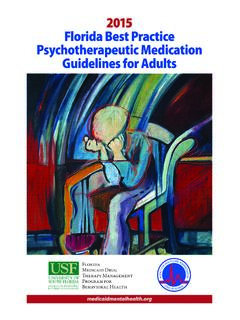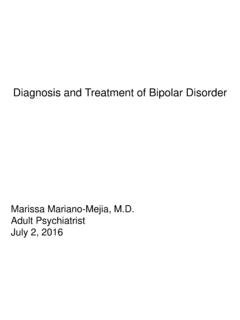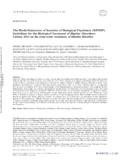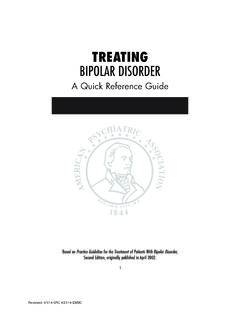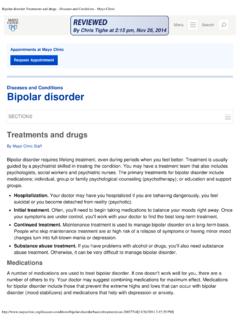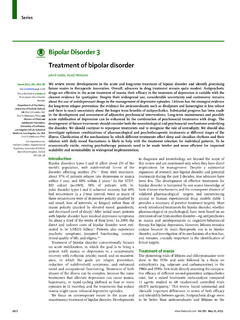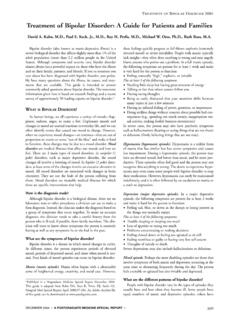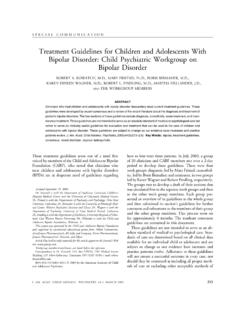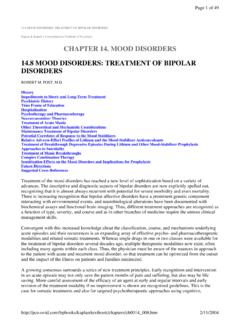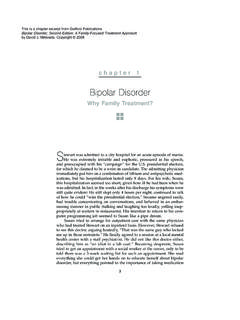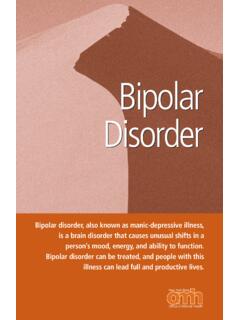Transcription of DSM-5 Criteria: Bipolar Disorders - medicaidmentalhealth.org
1 Pa g e 12 Criteria: Bipolar DisordersbiPolar i disorder:For a diagnosis of Bipolar I disorder, it is necessary to meet the following criteria for a manic episode. The manic episode may have been preceded by and may be followed by hypomanic or major depressive Episode: FA distinct period of abnormally and persistently elevated, expansive, or irritable mood and abnormally and persistently increased goal-directed activity or energy, lasting at least 1 week and present most of the day, nearly every day (or any duration if hospitalization is necessary). FDuring the period of mood disturbance and increased energy or activity, 3 (or more) of the following symptoms (4 if the mood is only irritable) are present to a significant degree and represent a noticeable change from usual behavior.
2 Inflated self-esteem or grandiosity Decreased need for sleep ( , feels rested after only 3 hours of sleep) More talkative than usual or pressure to keep talking Flight of ideas or subjective experience that thoughts are racing Distractibility ( , attention too easily drawn to unimportant or irrelevant external stimuli), as reported or observed Increase in goal-directed activity (either socially, at work or school, or sexually) or psychomotor agitation ( , purposeless, non-goal-directed activity) Excessive involvement in activities that have a high potential for painful consequences ( , engaging in unrestrained buying sprees, sexual indiscretions, or foolish business investments) FThe mood disturbance is sufficiently severe to cause marked impairment in social or occupational functioning, or to necessitate hospitalization to prevent harm to self or others, or there are psychotic features.
3 FThe episode is not attributable to the physiological effects of a substance ( , a drug of abuse, a medication, or other treatment ) or to another medical : A full manic episode that emerges during antidepressant treatment [ , medication, electroconvulsive therapy (ECT)], but persists at a fully syndromal level beyond the physiological effect of treatment is sufficient evidence for a manic episode, and therefore, a Bipolar I 1. DSM-5 Diagnosis: Bipolar I DisorderPa g e 13 Criteria: Bipolar Disorders (continued) Bipolar ii disorder: FCriteria have been met for at least one hypomanic episode and at least one major depressive episode FThere has never been a manic episode FThe occurrence of the hypomanic episode(s) and major depressive episode(s) is not better explained by schizoaffective disorder, schizophrenia, schizophreniform disorder, delusional disorder, or other specified or unspecified schizophrenia spectrum and other psychotic disorder.
4 FThe symptoms of depression or the unpredictability caused by frequent alternation between periods of depression and hypomania causes clinically significant distress or impairment in social, occupational, or other important areas of a diagnosis of Bipolar II disorder, it is necessary to meet the following criteria for a current or past hypomanic episode and the criteria for a current or past major depressive episode (See Box 3 on page 24 for Major Depressive Episode criteria).Hypomanic Episode: FA distinct period of abnormally and persistently elevated, expansive, or irritable mood and abnormally and persistently increased activity or energy, lasting at least 4 consecutive days and present most of the day, nearly every day.
5 FDuring the period of mood disturbance and increased energy and activity, 3 (or more) of the above symptoms (4 if the mood is only irritable) have persisted, represent a noticeable change from usual behavior, and have been present to a significant degree. FThe episode is associated with an unequivocal change in functioning that is uncharacteristic of the individual when not symptomatic. FThe disturbance in mood and the change in functioning are observable by others. FThe episode is not severe enough to cause marked impairment in social or occupational functioning or to necessitate hospitalization. If there are psychotic features, the episode is, by definition, manic. FThe episode is not attributable to the physiological effects of a substance ( , a drug of abuse, a medication, or other treatment ).
6 Note: A full hypomanic episode that emerges during antidepressant treatment ( , medication, ECT) but persists at a fully syndromal level beyond the physiological effect of that treatment is sufficient evidence for a hypomanic episode diagnosis. However, caution is indicated so that one or two symptoms (particularly increased irritability, edginess or agitation following antidepressant use) are not taken as sufficient for a diagnosis of a hypomanic episode nor necessarily indicative of a Bipolar 2. DSM-5 Diagnosis: Bipolar II DisorderPa g e 14 of Acute Bipolar Disorder - DepressionConduct comprehensive assessment and use measurement-based care. Refer to Principles of Practice on pages primary therapeutic objectives of Bipolar disorder care are remission, maintenance of remission, prevention of recurrence, and full functional recovery.
7 NSelection of acute treatment should take maintenance treatment goals into account. nBe aware of safety and tolerability concerns, evidence for maintenance use, and acute recommend psychiatric consultation prior to initiation of therapy + psychotherapeutic medication using a multi-disciplinary approach if treated by a 1 Established efficacy: FOptimize index mood stabilizer if already prescribed a mood stabilizer. Check blood levels if appropriate. FQuetiapine or lurasidone monotherapy**Notes: Only quetiapine has established efficacy for Bipolar II disorder. Lurasidone has a better metabolic profile than quetiapine. FLamotrigine monotherapy FLurasidone or lamotrigine** adjunctive to lithium or divalproex if index mood stabilizer has been optimized.
8 **Caution: There is a drug-drug interaction with use of lamotrigine and divalproex together that requires reducing the lamotrigine dose by 50% of the typical lamotrigine dose. For dosing recommendations, refer to Table 2 on page 19. FDo not utilize conventional antidepressants ( , SSRIs, SNRIs, TCAs, MAOIs) as a first-line 2A Established efficacy, but with safety concerns*: FOlanzapine + fluoxetine ( Bipolar I disorder)*Note: Tolerability limitations include weight gain and metabolic 2B Better tolerability, but limited efficacy*: FLithium ( Bipolar 1 disorder) F2 drug combination of above medications. Drugs may include either a first generation antipsychotic (FGA) or second generation antipsychotic (SGA) but NOT TWO antipsychotic medications*Note: Efficacy limitations, relatively few positive randomized controlled 3 If Levels 1 and 2 are ineffective and/or not well tolerated*: FElectroconvulsive therapy (ECT)*Note: Consideration is merited due to clinical need, despite even greater efficacy/tolerability limitations than Level 1 and 2 g e 15 of Acute Bipolar Disorder - Depression (continued)Level 4 If Levels 1 3 are ineffective and/or not well tolerated.
9 FCariprazine FFDA-approved agent for Bipolar disorder + conventional antidepressant ( , SSRI)* FPramipexole FAdjunctive: modafinil, thyroid hormone (T3), or stimulants F3 drug combination FTranscranial magnetic stimulation (TMS)*Notes: There is inadequate information (including negative trials) to recommend adjunctive antidepressants, aripiprazole, ziprasidone, levetiracetam, armodafinil, or omega-3 fatty acids for Bipolar depression. Preliminary evidence is available for cariprazine in the treatment for Bipolar I depression. Antidepressant monotherapy is not recommended in Bipolar I depression; recommendation is for adjunctive mood stabilizer with antidepressant.
10 Superiority (in other words, efficacy and safety) of antidepressant monotherapy versus adjunctive mood stabilizer with antidepressant for treatment of Bipolar II depression is 16 of Acute Bipolar Disorder - ManiaConduct comprehensive assessment and use measurement-based care. Refer to Principles of Practice on pages primary therapeutic objectives of Bipolar disorder care are safety, symptomatic improvement, and patient psychoeducation. nSelection of acute treatment should take maintenance treatment goals into account. nBe aware of safety and tolerability concerns, evidence for maintenance use, and acute recommend psychiatric consultation prior to initiation of therapy + psychotherapeutic medication using a multi-disciplinary approach if treated by a l 1A Established efficacy:Mild to moderate severity and/or not requiring hospitalization FOptimize mood stabilizer (lithium*, divalproex*, or carbamazepine*) if already prescribed.
